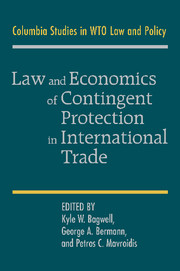Book contents
- Frontmatter
- Contents
- Contributors
- Introduction
- 1 An Overview of the Agreement on Subsidies and Countervailing Measures – Including a Discussion of the Agreement on Agriculture
- 2 Do the World Trade Organization Disciplines on Domestic Subsidies Make Sense? The Case for Legalizing Some Subsidies
- 3 Subsidies and Countervailing Measures: Determining the Benefit of Subsidies
- 4 The Enduring Problem of World Trade Organization Export Subsidies Rules
- 5 The Boeing–Airbus Dispute: A Case for the Application of the European Community State Aid Rules?
- 6 Antidumping: Overview of the Agreement
- 7 Price Differentiation in Antitrust and Trade Instruments
- 8 Nonpreferential Origin Rules in Antidumping Law and Practice
- 9 The Appellate Body Interpretation of “Sunset Reviews” Provisions of Anti-Dumping and Countervailing Measures Agreements: A Critical Analysis
- 10 The Safeguards Agreement – An Overview
- 11 Why Are Safeguards Needed in a Trade Agreement?
- Index
- References
11 - Why Are Safeguards Needed in a Trade Agreement?
Published online by Cambridge University Press: 03 May 2010
- Frontmatter
- Contents
- Contributors
- Introduction
- 1 An Overview of the Agreement on Subsidies and Countervailing Measures – Including a Discussion of the Agreement on Agriculture
- 2 Do the World Trade Organization Disciplines on Domestic Subsidies Make Sense? The Case for Legalizing Some Subsidies
- 3 Subsidies and Countervailing Measures: Determining the Benefit of Subsidies
- 4 The Enduring Problem of World Trade Organization Export Subsidies Rules
- 5 The Boeing–Airbus Dispute: A Case for the Application of the European Community State Aid Rules?
- 6 Antidumping: Overview of the Agreement
- 7 Price Differentiation in Antitrust and Trade Instruments
- 8 Nonpreferential Origin Rules in Antidumping Law and Practice
- 9 The Appellate Body Interpretation of “Sunset Reviews” Provisions of Anti-Dumping and Countervailing Measures Agreements: A Critical Analysis
- 10 The Safeguards Agreement – An Overview
- 11 Why Are Safeguards Needed in a Trade Agreement?
- Index
- References
Summary
This chapter reviews the theoretical and empirical literature on the use of safeguards in a trade agreement. It then analyzes the available data on the use of safeguards by World Trade Organization (WTO) members to examine two hypotheses in the economics literature: (i) that safeguards improve welfare by facilitating tariff reductions and (ii) that safeguards improve welfare by providing insurance against adverse economic shocks. I find that countries that undertook larger tariff reductions during the Uruguay Round conducted more safeguards investigations after the WTO was established. This finding suggests that the presence of a safeguard clause in the WTO agreement may have facilitated greater tariff reductions during the Uruguay Round. I find no evidence that safeguards are used more intensively by countries exposed to more aggregate economic uncertainty. It thus seems unlikely that safeguards provide insurance against aggregate economic shocks.
Introduction
Economists have a love–hate relationship with the idea of contingent policies in general and the use of safeguards in a trade agreement in particular. On the one hand, because the economic environment is constantly bombarded with sudden and unexpected changes in everything from technology, to individual preferences, to the weather, it makes sense to give the parties to a trade agreement some flexibility to change the terms of the agreement when something unexpected occurs. On the other hand, depending on the rules of the agreement, it is not clear that the benefits of flexibility outweigh their costs.
- Type
- Chapter
- Information
- Publisher: Cambridge University PressPrint publication year: 2009



